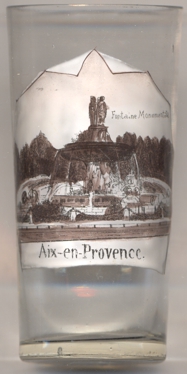

|
| FRANCE | FRANCE |
| région: Provence-Alpes-Côte d'Azur | |
| département: 13, Bouches-du-Rhône |
Aix-en-Provence is situated at an elevation of 252 m in a plain overlooking the Arc river, about 30 km north of Marseille in the région Provence-Alpes-Côte d'Azur os southern France. A former capital of Provence, it is the administrative seat (sous-préfecture) of the arrondissement Aix-en-Provence, in the département Bouches-du-Rhône. The municipality has a population of about 143,100 (2018).
 Aquae Sextiae was founded in 123 BC by the Romans following the destruction of the nearby Gallic oppidum at Entremont. In 102 BC its
vicinity was the scene of the Battle of Aquae Sextiae, where the Romans defeated the Ambrones and Teutones, with mass suicides among the captured women,
which passed into Roman legends of Germanic heroism. In the 4th century AD it became the metropolis of Narbonensis Secunda. It was occupied by the
Visigoths in 477. In the succeeding century, the town was repeatedly plundered by the Franks and Lombards, and was occupied by the Saracens in 731 and by
Charles Martel in 737. Aix, which during the Middle Ages was the capital of Provence, did not reach its zenith until after the 12th century, when,
under the houses of Barcelona / Aragon and Anjou, it became an artistic centre and seat of learning. Aix
passed to the crown of France with
the rest of Provence in 1487, and in 1501 Louis XII established there the parliament of Provence, which existed until 1789. In the 17th and 18th
centuries, the town was the seat of the Intendance of Provence. With the rise of Marseille to the regional center and capital of
the newly created Bouches-du-Rhône department, Aix lost its political influence and its importance. The city continued to attract artists, poets, and
writers. Aix was largely spared from the World War II. In the 1950s and 1960s, the city began to be awakened, which had been in a kind of deep slumber
since the 19th century. After the Algerian War and the country's independence, many French Algerians ('pieds noirs') who had returned to France settled
in Aix, as in other cities in the south, followed by Muslim immigrants from the Maghreb states. The population grew rapidly and there were large housing
estates on the outskirts. The city became a magnet for students. From 1970 high-tech settlements developed at the university. In addition, the city carried
out a renovation of the old town that was beneficial to tourism.
Aquae Sextiae was founded in 123 BC by the Romans following the destruction of the nearby Gallic oppidum at Entremont. In 102 BC its
vicinity was the scene of the Battle of Aquae Sextiae, where the Romans defeated the Ambrones and Teutones, with mass suicides among the captured women,
which passed into Roman legends of Germanic heroism. In the 4th century AD it became the metropolis of Narbonensis Secunda. It was occupied by the
Visigoths in 477. In the succeeding century, the town was repeatedly plundered by the Franks and Lombards, and was occupied by the Saracens in 731 and by
Charles Martel in 737. Aix, which during the Middle Ages was the capital of Provence, did not reach its zenith until after the 12th century, when,
under the houses of Barcelona / Aragon and Anjou, it became an artistic centre and seat of learning. Aix
passed to the crown of France with
the rest of Provence in 1487, and in 1501 Louis XII established there the parliament of Provence, which existed until 1789. In the 17th and 18th
centuries, the town was the seat of the Intendance of Provence. With the rise of Marseille to the regional center and capital of
the newly created Bouches-du-Rhône department, Aix lost its political influence and its importance. The city continued to attract artists, poets, and
writers. Aix was largely spared from the World War II. In the 1950s and 1960s, the city began to be awakened, which had been in a kind of deep slumber
since the 19th century. After the Algerian War and the country's independence, many French Algerians ('pieds noirs') who had returned to France settled
in Aix, as in other cities in the south, followed by Muslim immigrants from the Maghreb states. The population grew rapidly and there were large housing
estates on the outskirts. The city became a magnet for students. From 1970 high-tech settlements developed at the university. In addition, the city carried
out a renovation of the old town that was beneficial to tourism.
The  fontaine de la Rotonde (on glass no. 4006 [left] named 'fontaine monumentale') is probably
the best-known fountain in Aix-en-Provence. It was designed by the Ponts et Chaussées engineer Théophile de Tournadre and was
inaugurated in 1860. The city of Aix built this fountain to celebrate the arrival of the long-awaited water from the Zola Canal. Its basin has a diameter
of 32 metres and the fountain stands 12 metres high. The total diameter of the monument is 41 metres.
fontaine de la Rotonde (on glass no. 4006 [left] named 'fontaine monumentale') is probably
the best-known fountain in Aix-en-Provence. It was designed by the Ponts et Chaussées engineer Théophile de Tournadre and was
inaugurated in 1860. The city of Aix built this fountain to celebrate the arrival of the long-awaited water from the Zola Canal. Its basin has a diameter
of 32 metres and the fountain stands 12 metres high. The total diameter of the monument is 41 metres.
[https://de.wikipedia.org/wiki/Aix-en-Provence, https://en.wikipedia.org/wiki/Aix-en-Provence;
http://www.fallingrain.com/world/FR/B8/AixenProvence.html;
https://fr.wikipedia.org/wiki/Fontaine_de_la_Rotonde]
![[scale]](lineal.jpg)